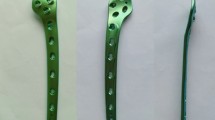Abstract
Background: Femoral intramedullary nails with antegrade or retrograde options for insertion and different locking possibilities have extended the indications to include both diaphyseal and metaphyseal fractures.
Patients and Methods: A prospective series of 63 patients were treated with three different unreamed nailing and interlocking techniques selected according to the predominant fracture location. Median age of the 30 women and 33 men was 39 (17–97) years. High-energy injuries had occurred in 37 patients. Antegrade nailing and interlocking with standard technique was used in 29 diaphyseal fractures, antegrade nailing and placement of the proximal locking device to the femoral head was performed in eleven proximal fractures with involvement of the intertrochanteric region, and retrograde nailing and standard interlocking was done in 23 mainly distal fractures.
Results: We encountered two types of major mechanical complications: angular malalignment and protrusion of the nail into the knee joint following compression in the fracture. Angular malalignment was found in four fractures. One midshaft fracture was fixed in a valgus reduction. Varus malalignment and loss of fixation occurred in two high subtrochanteric fractures after proximal locking with a spiral blade. In another midshaft fracture redisplacement in varus occurred. Compression in the fracture with protrusion of the nail by 2–10 mm into the knee joint following retrograde nailing was observed in six osteoporotic patients. Only two of these patients had significant knee problems. The median time to union – 4 months – did not differ significantly between the fixation groups.
Conclusions: Thus, there are still problems after nailing very proximal and distal fractures. Most postoperative complications were seen after retrograde nailing of distal fractures, but the consequences of fixation failure in very proximal fractures were worse. Nevertheless, a protocol that takes advantage of the different options for nail introduction and locking depending on the fracture location seems promising.
Similar content being viewed by others
Author information
Authors and Affiliations
Additional information
Received: January 6, 2002; revision accepted: October 8, 2002
Correspondence Address Karl Akke Alberts, MD, PhD, Department of Orthopedics, Karolinska Hospital, 17176 Stockholm, Sweden, Phone (+48/8) 517-70000, Fax -72695, e-mail: akke.alberts@ks.se
Rights and permissions
About this article
Cite this article
Alberts, K., Stark, A. Unreamed Nailing of Diaphyseal and Metaphyseal Fractures of the Femur . Eur J Trauma 28, 289–294 (2002). https://doi.org/10.1007/s00068-002-1197-9
Issue Date:
DOI: https://doi.org/10.1007/s00068-002-1197-9




